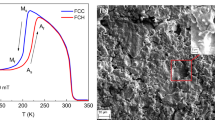Summary
Magnetoelastic wave amplitude, a, was measured vs. the temperature during thermal cycles in Metglas 2826. When the Curie temperature, T C, has been reached, the A value vanishes due to the fall of the magnetoelastic coupling in the paramagnetic state. This allows evaluation of the T c temperature. The latter increases after the iterated thermal treatments while the magnetic anisotropy K u decreases. Also the A amplitude, measured at room temperature after the subsequent thermal treatments, shows an increasing behaviour. The values of K u, T c and A approach saturation after the same number of thermal cycles; this suggests that the structural relaxation produced by annealing is the microscopic mechanism governing all the three physical quantities. In particular we explain the connection between K u and A by means of the longitudinal magnetostriction.
Riassunto
L’ampiezza delle onde magnetoelastiche, A, è stata misurata in funzione della temperatura eseguendo cicli termici nel Metglas 2826. Raggiunta la temperatura di Curie, T C l’ampiezza A si annulla a causa della transizione dell’accoppiamento magnetoelastico nello stato paramagnetico. Ciò ci mette in grado di misurare la temperatura T C; quest’ultima aumenta in seguito ai ripetuti trattamenti termici mentre l’anisotropia magnetica K u diminuisce. Anche l’ampiezza A, misurata a temperatura ambiente dopo i trattamenti termici, mostra un andamento crescente. I valori di K u, T c e A tendono alla saturazione dopo lo stesso numero di cicli termici; ciò suggerisce che il rilassamento strutturale prodotto dalla ricottura è il meccanismo microscopico che regola le tre grandezze fisiche menzionate. In particolare noi mostriamo che K u e A sono legati dalla magnetostrizione longitudinale.
Резюме
Измеряется зависимость амплитуды магнитноупругой волны, A, от температуры в течение температурных циклов в металлическом стекле 2826. При достижении температуры Кюри, T c, величина A обращается в нуль из-за уменьшения магнитноупругой связи в парамагнитном состоянии. Это позволяет оценить темпаратуру Кюри, T c. Температура Кюри увеличивается после повторных температурных обработок, тогда как магнитная анизотропия K u уменьшается. Также отмечается увеличение амплитуды A, измеренной при комнатной температуре после последовательных температурных обработок. Величины K u, T c и A приближаются к насьщению после одинакового числа температурных циклов. Это результат предполагает, что структурная релаксация, обусловленная отжигом, представляет микроскопический механизм, определяющий все три физические величины. В частности, мы объсняем связь между K u и A с помощью продольной магнитострикции.
Similar content being viewed by others
References
E. du Tremolet de Lacheisserie: J. Magn. Magn. Mater., 25, 251 (1980).
L. Lanotte, C. Luponio and F. Porreca: J. Appl. Phys., 54, 4520 (1983).
K. I. Arai, N. Tauya and M. Yamada: IEEE Trans. Magn., 8, 936 (1980).
B. S. Berry, W. C. Pritchet and H. T. Savage: J. Appl. Phys., 49, 6075 (1978).
A. Hernando, V. Madurga and M. Vasquez: J. Appl. Phys., 52, 1451 (1981).
H. S. Chen: J. Appl. Phys., 49, 3289 (1978).
W. P. Mason: Physical Acoustics and the Properties of Solids, (Van Nostrand, Princeton, N.J., 1958), Chap. X.
H. Fahlenbranch and H. H. Meyer: Z. Techn. Phys., 21, 40 (1980).
W. P. Mason and H. J. McSkimin: J. Acoust. Soc. Am., 19, 464 (1947).
L. Lanotte, C. Luponio and F. Porreca: J. Appl. Phys., 50, 438 (1979).
L. Lanotte, C. Luponio, P. Matteazzi and F. Porreca: J. Magn. Magn. Mater., 61, 225 (1986).
T. Egami: J. Magn. Magn. Mater., 31–34 1571 (1983).
L. Lanotte, P. Matteazzi and V. Tagliaferri: Proceedings of the 5th International Conference on R.Q.M., edited by S. Teeb and H. Warlimont (Elsevier Sc. Publishers B. V., 1985), p. 1199.
L. Lanotte, P. Matteazzi and V. Tagliaferri: J. Magn. Magn. Mater., 42, 183 (1984).
A. Chamberod, W. Chamberod and J. Hillairet: Les amorphes metalliques, Ecole d’Hiver-Aussois (Les Editions de Physique, 1983), p. 329–403.
P. J. Flanders, N. Morito and T. Egami: IEEE Trans. Magn., MAG-19 (5), 1910 (1983).
G. Dietz, K. Huller, R. Haussmann and K. Kolpin: J. Magn. Magn. Mater., 59, 316 (1986).
R. M. Bozorth: Ferromagnetism (van Nostrand, Princeton, N.J., 1968), p. 615–641.
Author information
Authors and Affiliations
Rights and permissions
About this article
Cite this article
Lanotte, L., Luponio, C. & Porreca, F. Effect of structural relaxation on Curie temperature and magnetostriction investigated by magnetoelastic waves in metglas. Nouv Cim D 11, 1763–1772 (1989). https://doi.org/10.1007/BF02459120
Received:
Issue Date:
DOI: https://doi.org/10.1007/BF02459120



